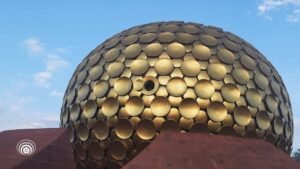The Matrimandir, with its gleaming golden sphere, stands as a radiant beacon at the core of Auroville, casting its spiritual light far and wide. This architectural marvel isn’t just a structure; it’s a testament to the transformative power of vision, dedication, and the quest for higher consciousness. In this article, we delve into the Matrimandir’s rich history, from its conception to the profound influence it exerts on Auroville’s life.
A Brief History of Conception
The Matrimandir’s story begins in June 1965 when the Mother, the spiritual luminary behind Auroville, articulated her vision to establish a “universal town” where people of all nations could coexist harmoniously, transcending the boundaries of creed, politics, and nationality. Her objective was clear: to realize human unity.
At the heart of her envisioned town, the Mother proposed the creation of a “Park of Unity.” Within this park, a structure initially referred to as the “Pavilion of Truth,” “Pavilion of [Divine] Love,” or “Pavilion of the Mother” was planned. Eventually, this sanctuary was officially named “Matrimandir,” translated to “The Mother’s Shrine” in English. The “Park of Unity” was conceived to feature twelve gardens, each representing one of the “twelve attributes of the Mother,” and would eventually be encircled by a lake.
The Story of Conception Unfolds
Towards the end of 1965, the Mother made a significant decision: a solitary Banyan tree would be designated as the geographical center of the forthcoming town. At that time, the site was barren, devoid of the lush greenery that would later flourish.
In early 1968, the Mother bestowed names upon the twelve gardens surrounding the Matrimandir. These gardens were christened as “Existence,” “Consciousness,” “Bliss,” “Light,” “Life,” “Power,” “Wealth,” “Utility,” “Progress,” “Youth,” “Harmony,” and “Perfection.” The inauguration ceremony of Auroville took place on February 28, 1968, during which the soil of various Indian states and countries worldwide was placed in a white Urn shaped like a lotus bud. This Urn now stands at the center of a vast amphitheater.
Later in 1969, the Mother provided insights to an American horticulturist named Narad, who was entrusted with the responsibility of crafting the Matrimandir Gardens. She emphasized the need for the gardens to be “a thing of great beauty,” embodying the consciousness they sought to manifest. She stressed the importance of moving from one state of consciousness to another seamlessly.
Architectural Marvel Takes Shape
In January 1970, the Mother entrusted the task of designing the Matrimandir to French architect Roger Anger. She had experienced visions of the Inner Chamber of the Matrimandir and provided Anger with a measured drawing of it, meticulously created according to her precise instructions. However, the Mother mentioned that she hadn’t visualized the rest of the building.
By March 1970, Roger Anger presented the Mother with a model of the Inner Chamber, along with five different models for the Matrimandir’s overall structure. The Mother selected a model that resembled a slightly flattened golden sphere, and Anger continued to refine this design.
The Approved Model and the Path Forward
In 1970, the Mother addressed concerns about the Matrimandir’s location and the surrounding water. She affirmed that the Matrimandir would eventually be encircled by water, but due to logistical constraints, this feature would be added later. The exact size and shape of the surrounding lake remained undecided during her lifetime.
In February 1971, the Mother approved a new model presented by Roger Anger. This model depicted the Matrimandir on an oval island, resembling a lotus in full bloom emerging from twelve large “petals.” This model laid out the arrangement of the island, the twelve gardens, the central Banyan tree, the Amphitheatre, and more. It defined the Matrimandir Island’s shape as an oval, corresponding to the vertical section of the Matrimandir but on a larger scale (360m x 290m).
The foundation stone for the Matrimandir was laid on February 21, 1971, and three weeks later, excavation work commenced. Initially, Aurovilians undertook the excavation, but the task was so massive that around 400 local laborers were hired to expedite the process.
A nursery was established near the Matrimandir site in early 1971. Its purpose was to acclimate, study, and propagate the plants required for the Matrimandir Gardens. When the question arose about whether the nursery workers should shift their focus to digging the foundation hole for the Matrimandir, the Mother’s response was unequivocal: “No, the gardens are as important as the Matrimandir itself.”
On February 21, 1972, the first concrete was poured for the foundation, marking another significant milestone in the Matrimandir’s construction.
The Spiritual Significance of Matrimandir
The Matrimandir is dedicated to the Universal Mother, a divine presence and being that has been revered across cultures throughout history, albeit under different names—Isis, Pachamama, Kwannon, Aditi, Virgin Mary, and many more. However, Matrimandir isn’t dedicated to a particular incarnation or emanation of the Mother. It represents the principle of the Mother, the creative and realizing force in the universe.
As Sri Aurobindo eloquently explained, the same divine force may be recognized and worshipped by various names in different faiths, illustrating the diversity of human interpretations while acknowledging the unity of the divine essence. The Mother embodies the universal and cosmic aspects of this divine force, serving as the bridge between the transcendent and individual levels of consciousness.
Conclusion: A Symbol of Oneness and Divine Presence
The Matrimandir’s journey, from conception to realization, mirrors the transformative evolution of Auroville itself. It stands as a testament to the vision of the Mother and the collective endeavor to manifest a space that symbolizes unity, spirituality, and the pursuit of higher consciousness. The Matrimandir isn’t merely a physical structure; it’s a profound embodiment of the universal Mother and a source of inspiration for all who seek to awaken their inner divinity. It continues to influence Auroville’s life, fostering a sense of oneness and spiritual aspiration among its inhabitants, and serving as a timeless symbol of human unity and the divine presence in our world.




